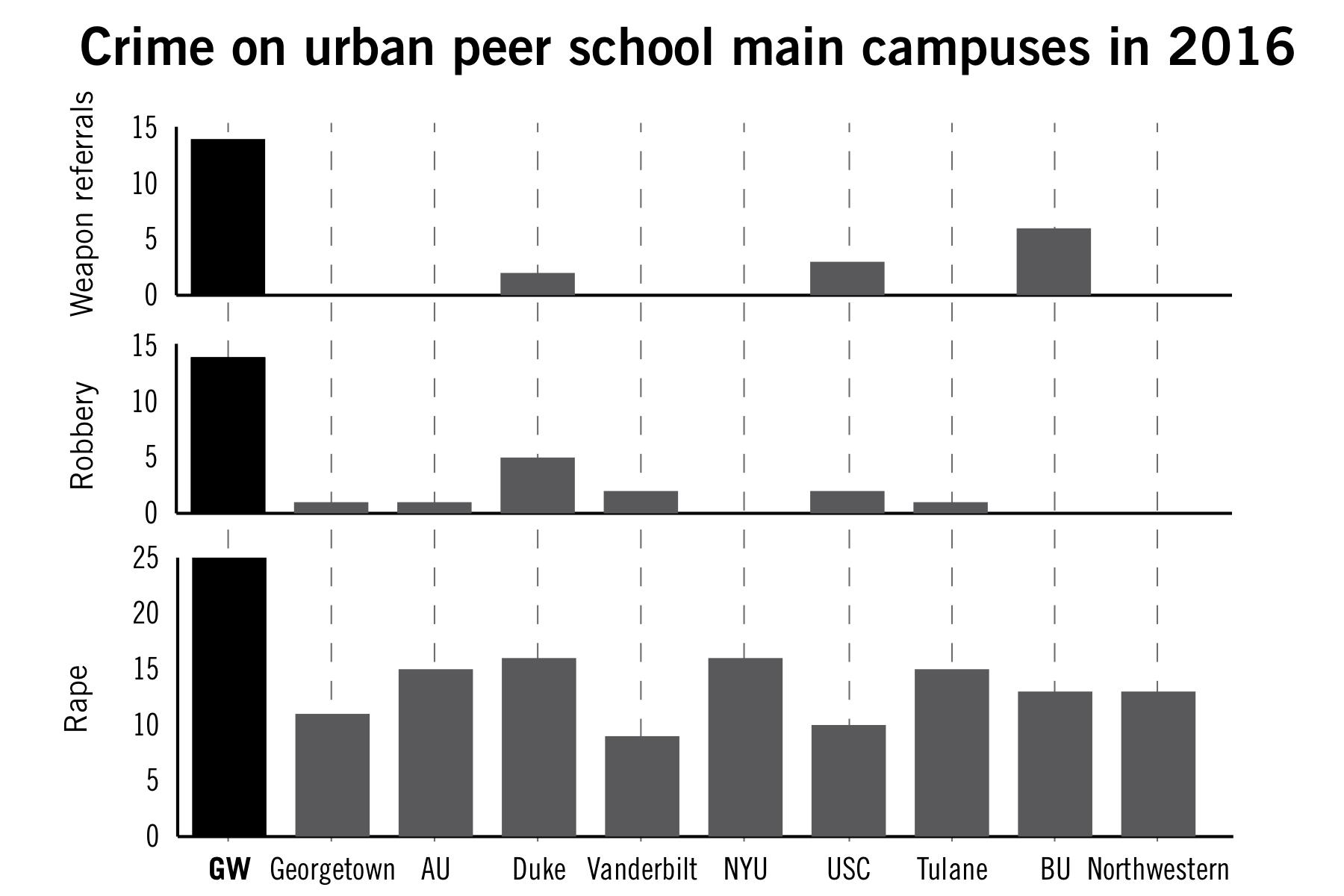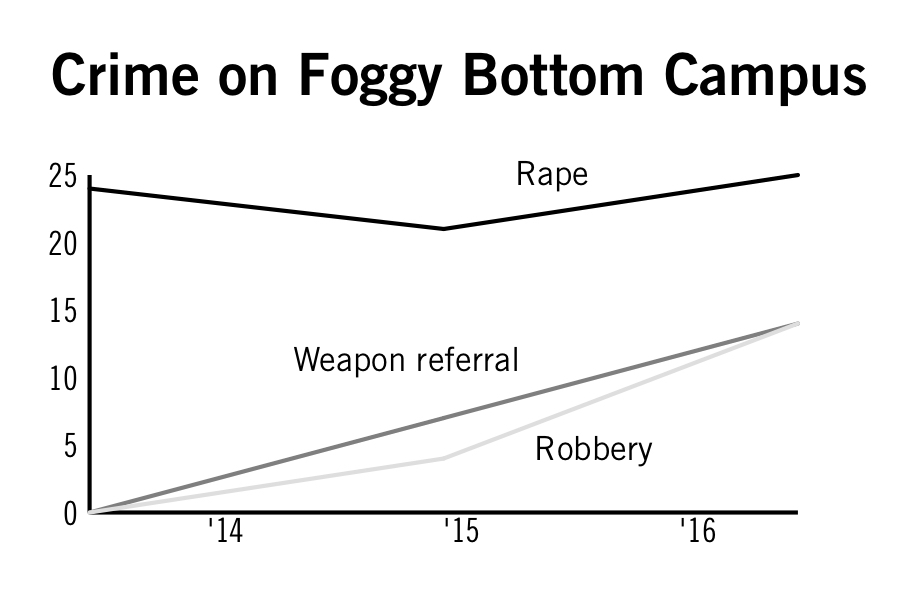
Yonah Bromberg Gaber | Graphics Eidtor
Source: Annual Security Reports
GW recorded a higher number of rapes, robberies and disciplinary referrals for weapons on the Foggy Bottom Campus last year than most of its peer institutions.
Robbery cases and weapons referrals both jumped in 2016, and the University recorded the highest number of rapes in at least the last five years, according to its annual security report released last month. Campus security and crime experts said these cases can rise if campus crime rates are increasing or if the University changes how it enforces policies and encourages more students to report incidents.
GW documented 14 robberies and 14 weapons referrals last year, while its 14 peer schools averaged two robberies and fewer than one weapons referral on their main campuses. While GW documented 25 campus rapes, 13 peer schools recorded an average of nearly 12 rapes on campus, according to security reports.
Southern Methodist University was excluded in the rape and fondling analysis because its security report does not record rape separately from forcible sexual offenses.
University spokeswoman Maralee Csellar declined to comment on how GW compared to peer schools, saying the Division of Safety and Security is not familiar with crime statistics or policing and education efforts at other institutions.
“Here, at GW, we will continue to analyze a variety of factors when determining the safety and security of all of our campuses with the goal of creating a safe environment for all GW community members,” Csellar said in an email.
But experts said reasons as simple as student population and the location of the institution will be two of the most significant factors in determining how many crimes will occur at a university.
Out of its peers, GW has the fourth-highest total student population at 27,159. The average total population of peer universities is 20,771, with 10 institutions having fewer than 20,000 students, according to the National Center for Education Statistics.
Ten of GW’s peer schools are classified as city schools by the National Center for Education Statistics.
Soaring robbery rates
Last year, GW documented 14 robberies on the Foggy Bottom Campus – an increase from zero in 2014 and four in 2015 and the highest of any of its peer universities.

Yonah Bromberg Gaber | Graphics Eidtor
Source: Annual Security Reports
Washington University in St. Louis, with eight robbery cases last year, documented the second-highest number of those crimes, according to its annual security report.
Meanwhile, the number of burglaries at GW fell from 21 in 2015 to 13 in 2016. Burglaries nearly doubled between 2012 and 2013.
Experts said the variation in robbery reports among universities could result from a random increase in cases or a university’s efforts to conduct prevention education.
Gary L. Sigrist Jr., CEO of Safeguard Risk Solutions, an emergency management organization, said if the culprits are students, the University should implement strong disciplinary policies like expelling students from the institution.
But at an open, urban campus like GW, he said if off-campus individuals are committing the crimes, the University should educate the community about behaviors that mitigate the potential for victimization, like paying attention while walking.
“Students today unfortunately put themselves at risk because they’re either always looking at their phone or they always have their headphones on and in doing so you lose some of your situational awareness,” he said.
Weapons referrals rise
The number of disciplinary referrals for weapons violations on the Foggy Bottom Campus doubled from seven in 2015 to 14 last year.
Darrell Darnell, the senior associate vice president for safety and security, said most of the referrals occurred when students brought knives into residence halls. In other cases, students have brought back bullets or shell casings from a gun range, a violation of University policy.
“It’s been those types of things – it hasn’t been anything that we thought was an overarching threat to anyone in the residence halls,” he said in an interview last month. “While it’s something that we take seriously it is not something that would threaten the safety of our students.”
GW’s policy bans weapons – like pocket knives, spears, swords, firearms, ammunition and tasers – in residence halls, according to its website. Twelve out of the 14 peer schools mentioned banning some knives in their weapons policies, while two did not.
W. Scott Lewis, a partner at the National Center for Higher Education Risk Management, said most schools have some policies against knives on campus, typically prohibiting large hunting knives, sabers, swords or katanas.
“Usually the only way we find out about them in the institution in the residence halls is either the safety checks we do periodically in the building or more common somebody’s brandishing the weapon and showing people,” he said.
Rape cases at five-year high
The University recorded the second highest number of rapes – 25 – compared to 13 main campuses of its peer schools. The only school with a larger number of rape cases was the Washington University in St. Louis, which documented 36, according to its security report.
Experts said the more active a university is about promoting reporting for sexual crimes, the more students will come forward to report incidents.
GW also had an above-average number of fondlings on its campus, compared to the 13 peer schools that documents those incidents.
Michael Dorn, the executive director of the security consulting firm Safe Havens International, said a number of factors could contribute to a higher rape count at a university, including the geographical location and culture of reporting at the institution. An environment of support for survivors may vary from state to state, he said.
Six of GW’s peer schools are located in the South, while four are located along the East Coast, two in the Midwest and one in the West.
“If victims feel like the university is more likely to act and investigate an incident early, then a victim is probably more likely in many cases more likely to come forward,” he said.
Leah Potter and Jackie Torrez contributed reporting.




